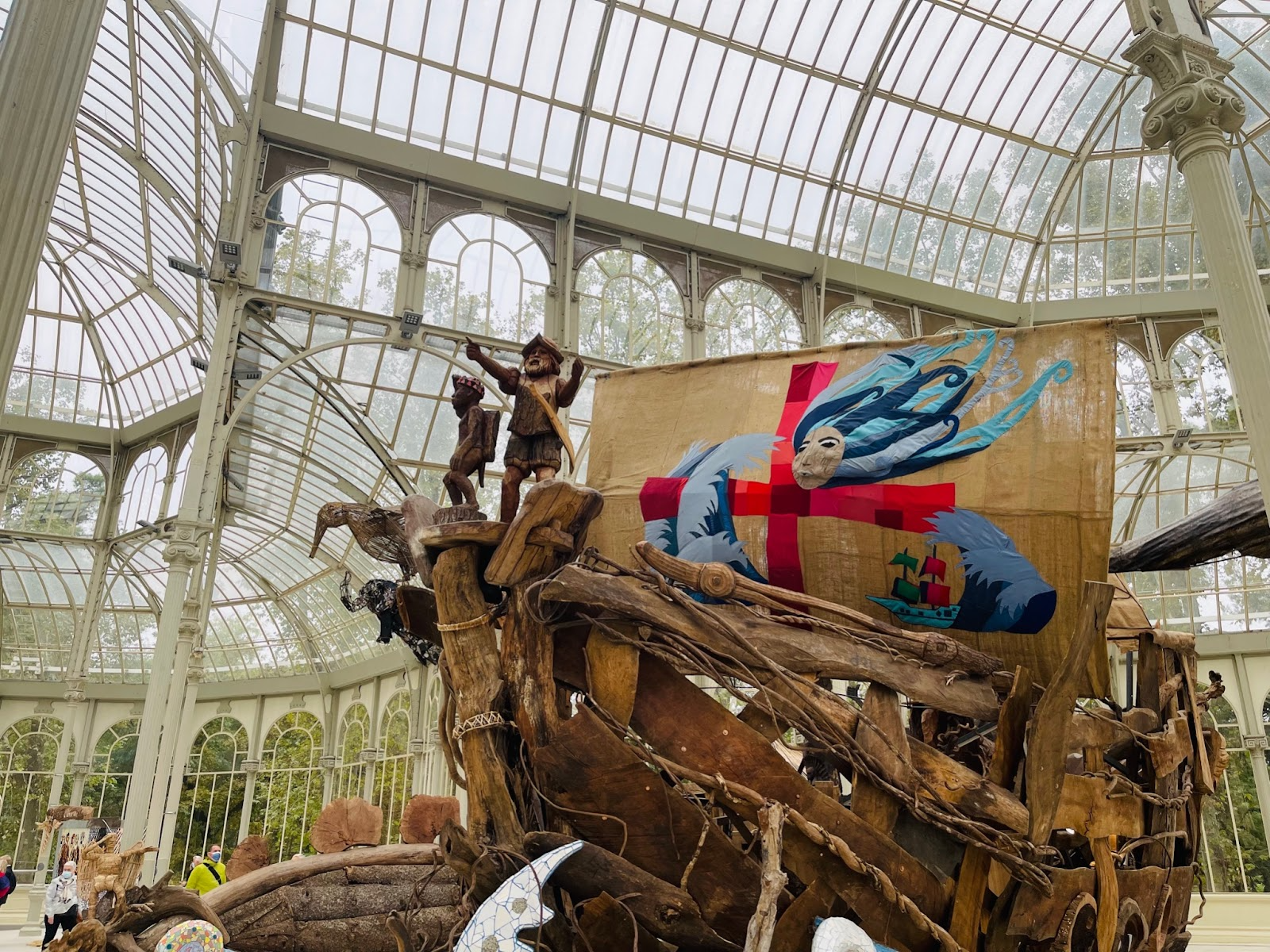‘Magellan, Marilyn, Mickey & Fr. Dámaso. 500 Years of Conquistador RockStars’ at Madrid’s Palacio de Cristal
National Artist for Film Kidlat Tahimik mounts materials by Filipino craftsmen as his lens to represent the impact of imperialism on local cultures.
Words and Photos by Pio Angelo Ocampo
March 24, 2022
Located at the center of the exhibition is an installation art reenacting the ‘Philippine Exposition’ in 1887
Well-known for his contributions as a film director, writer, and actor, Kidlat Tahimik (Eric Oteyza de Guia) has an oeuvre that is associated with ‘Third Cinema’— a movement that decries capitalist structures governing productivity and consumption, which in turn critiques the money making industry of Hollywood cinema. Today, Tahimik sublimates his artistic practice as a filmmaker into his installation art, creating architectural conventions that stage historical narratives with magical realism. With this intention, Tahimik unveils ‘Marilyn, Mickey & Fr. Dámaso. 500 Years of Conquistador RockStars’, in partnership with Museo Nacional Centro de Reina Sofía, at the Palacio de Cristal (Glass Palace) in the UNESCO Heritage Site, El Retiro Park, Madrid.
The setting for this exhibition is not unfamiliar with Filipino indigenous art and is infamous for its fair share of historical controversy. In 1887, the Glass Palace hosted the General Exhibition on the Philippine Islands, an event claiming to increase commercial and economic relations between the archipelago and its imperial overlords; which only resulted in a “human zoo” exoticizing indigeneous populations. And as Tahimik does with his films, he invites his audiences to become witnesses in an unfolding narrative of globalization and colonial violence— creating a new exposition analyzing the fifth centenary from the first encounter between Spain and the Philippines.
A boat representing Magellan and his slave, Enrique de Malacca, of which the latter was said to be a translator of the Visayan lingua franca according to Antonio Pigafetta.
An epic stage of native resistance from European and North American imperialist cultures devours the entirety of the Glass Palace. Upon entrance, one is confronted by material unity— a scheme of carvings, sculptures, and weavings— bound by salvaged and repurposed wood, coconut husks, rattan, and other indigenous materials. As polish, the installations are rooted in soil, mooring shared antiquities to the harbors of today.
A seemingly seaborne war between a triumphant native and a defeated, ironclad colonizer, such as that of the Battle of Mactan.
Scenes between conquistadors and indigenous figures tower over one another, as if in a dream sequence with and against the currents of time. While the project invokes imagery from centuries past, it anchors its contemporary witnesses by weaving in consumerist found objects— mass-produced packaging, electronics, and other plastics. This cadence is retained even in the installation’s details, creating a militant dynamism in the way the entire project is realized.
Steeped in Tahimik’s practice in film, the figure of the movie camera serves as a recurring emblem. In one of the installations, a behemoth trojan horse with a movie camera for its head confronts a towering stack of Bulul wooden figures. With a closer look, Spiderman figurines made of wicker, as if behest to an imperial American Odysseus, are climbing out of the horse with an ostensive poise to ambush the slumped population of the Bulul.
Left: A trojan horse with a movie camera for its head confronts a slumped stack of Bulul wood carvings. Center: A recreation of Juan Luna’s Spoliarium in the Bellas Artes in wicker and mixed media. Right: Kidlat Tahimik at El Retiro Park sharing meditations and histories in a picnic arranged by the Philippine Embassy in Spain.
A couple weeks prior to the opening of the exhibition, the Philippine Embassy in Spain organized a picnic with Kidlat Tahimik near Palacio de Cristal in Retiro Park. It was mostly attended by different Filipino students and overseas workers, sharing diasporic stories in between bites of puto at kutsinta. At the center of this gathering, Tahimik recalls narratives that subvert the Western colonial canon.
In one of his stories during this picnic, he recounts the namesake of his cinematheque (Balanghai ni Ikeng theatre at Ili Likha Artist Village), Enrique de Malacca, a Malay native who was a slave of the Portuguese explorer Ferdinand Magellan; a character further explored in his internationally acclaimed 2015 film ‘Balikbayan #1 Memories of Overdevelopment Redux III’. Tahimik narrates the accounts of Italian historian Antonio Pigafetta that Enrique spoke the Visayan lingua franca, translated for Magellan, and further speculated how he was the first Filipino who circumnavigated the world. “Kahit, hindi pa Pilipino ang tawag sa atin noon,” Tahimik clarifies “—tatawagin natin siyang Pinoy.” We claim him to be Filipino as reference.
Exterior of Palacio de Cristal in El Retiro Park
Kidlat Tahimik’s Magellan, Marilyn, Mickey & Fr. Dámaso. 500 Years of Conquistador RockStars runs from 29 October, 2021 to 6 March, 2022 at the Palacio de Cristal in El Retiro Park, Community of Madrid, Madrid, Spain. Tahimik is also presenting his latest film at the Museo Nacional Centro de Reina Sofía where it is described as “a new edit of a project spanning thirty years on the circumnavigation of the Earth and Western accounts of the ‘discovery’ of the New World.”
Author’s bionote:
Pio Angelo Ocampo recently graduated from De La Salle-College of Saint Benilde’s Arts Management program where he served as president (A.Y. 2019-2020) of the program’s home.







